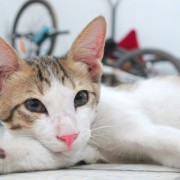Understanding cats better – body language
Part 2 – The Body Language of Cats
Cats communicate not only acoustically but also through their bodies, sometimes very subtly and almost imperceptibly for us humans. Therefore, it’s even more important to be able to interpret our cat’s more obvious signals.
The tail position of the cat conveys a lot about its mood. An upright tail that moves lightly and gracefully back and forth signals a friendly greeting. A slight trembling in this position indicates excitement. However, the faster the tail starts moving, whipping around, the higher the excitement and the more aggressive the mood. Puffing up the tail or the back ridge is a gesture of threat. If the fur all over the body stands on end, it indicates fear.
However, the biggest indicator of mood is found in the head area. All parts of the head reflect the cat’s mood.
The cat’s mood is best recognized through its ears. When the ears are upright and pointing forward, it’s a sign of a friendly, curious mood. The further the ears turn back and bend towards the head, the tenser the mood becomes.
Also, the facial whiskers, or vibrissae, provide insight into the cat’s mood. When stretched forward, they indicate curiosity, readiness for action, but also an imminent attack. Pulled backward means “don’t come too close,” the cat wants its space or isn’t feeling well. They also pull them back when sniffing.
When the eyes of the cat are wide open and are fixated on you or another cat, caution is advised. It’s provocative and could signify an attack, but also fear or vigilance. Half-closed eyes or a blink indicate the cat’s smile, a friendly gesture. Dilated pupils indicate fear, surprise, defense… or it’s dark 😉. Narrow, slit-like pupils are shown by the cat when interested, tense, or threatening… or when the sun is shining 😉.
Also, nose licking often has a meaning. After eating or sniffing, it’s normal, but if the cat licks its nose in other situations, it could signal tension, stress, or even nausea.
And your cat doesn’t yawn only when tired. Cats also yawn when stressed and tense or as a appeasement gesture or greeting.

Boris and Lilly, the Devon Rexes from Profeline, in a private moment – by the way, Lilly is teething here 😉
Yawning, sudden hectic grooming, or paw/head shaking can also be so-called displacement behaviors. These occur when the cat can’t decide between two actions and is in conflict. For example, should I attack or run away? Should I stay here or hide? Should I pounce on my prey or wait and see? These displacement behaviors can occur in such situations.

Katzenseelchen
Claudia Fellini

About Claudia Fellini – Cat Psychologist and Cat Behavior Consultant
Quote from her website Katzenseelchen: “As a originally trained office clerk, I’ve enjoyed the company of animals, especially cats, my whole life. I live with 3 male cats and a female cat, all of them from animal shelters and each with a unique history.
The nature of cats has always fascinated me, and my love for them led me not only to my involvement in animal welfare but also to a growing interest in cat psychology. The work of various cat experts, cat professionals, and cat whisperers fascinated me. I was impressed by what a cat therapist can achieve with specific behavioral therapy. I wanted to understand cat behavior, so to speak, learn and understand “cat language,” what they need, and what makes them happy.” More about Katzenseelchen














